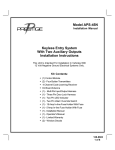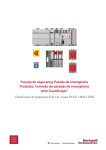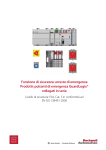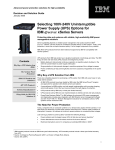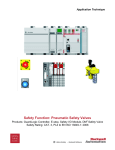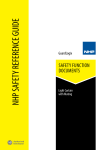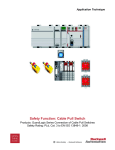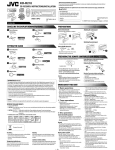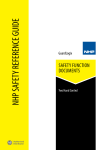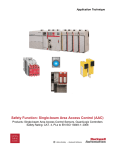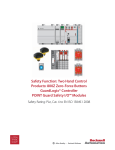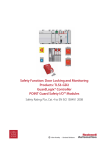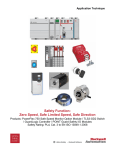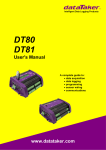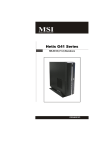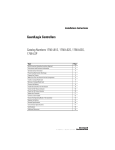Download Emergency Stop Safety Function
Transcript
NHP SAFETY REFERENCE GUIDE GuardLogix SAFETY FUNCTION DOCUMENTS Emergency Stop Safety Function Documents: GuardLogix Safety Function: Emergency Stop Products: GuardLogix® Series Connection of E-stops Safety Rating: PLd, Cat. 3 to EN ISO 13849.1 2008 Table of Contents: Introduction 6-121 Important User Information 6-121 Safety Function Realization 6-122 General Safety Information 6-122 Setup and Wiring 6-123 Configuration 6-124 Programming 6-128 Falling Edge Reset 6-129 Verification and Validation Plan 6-131 Additional Resources 6-134 NHP Safety Reference Guide > Safety Function Documents: GSR 6A-126 Safety Function Documents: GuardLogix Safety Function: Emergency Stop Products: GuardLogix® Series Connection of E-stops Safety Rating: PLd, Cat. 3 to EN ISO 13849.1 2008 Introduction Important User Information This Safety Function application note explains how to wire, configure, and program a Compact GuardLogix® controller and POINT Guard I/O™ module to monitor a series of dual-channel safety E-stop devices. If any of the E-stops is actuated or a fault is detected in the monitoring circuit, the GuardLogix controller de-energizes the final control device, in this case, a redundant pair of 100S contactors. Solid state equipment has operational characteristics differing from those of electromechanical equipment. Safety Guidelines for the Application, Installation and Maintenance of Solid State Controls (publication SGI-1.1 available from your local Rockwell Automation® sales office or online at http://www. rockwellautomation.com/literature) describes some important differences between solid state equipment and hard-wired electromechanical devices. Because of this difference, and also because of the wide variety of uses for solid state equipment, all persons responsible for applying this equipment must satisfy themselves that each intended application of this equipment is acceptable. This example uses a Compact GuardLogix controller, but is applicable to any GuardLogix controller. In no event will Rockwell Automation, Inc. be responsible or liable for indirect or consequential damages resulting from the use or application of this equipment. The examples and diagrams in this manual are included solely for illustrative purposes. Because of the many variables and requirements associated with any particular installation, Rockwell Automation, Inc. cannot assume responsibility or liability for actual use based on the examples and diagrams. No patent liability is assumed by Rockwell Automation, Inc. with respect to use of information, circuits, equipment, or software described in this manual. Reproduction of the contents of this manual, in whole or in part, without written permission of Rockwell Automation, Inc., is prohibited. NHP Safety Reference Guide > Safety Function Documents: GSR 6A-127 Safety Function Documents: GuardLogix Safety Function: Emergency Stop Products: GuardLogix® Series Connection of E-stops Safety Rating: PLd, Cat. 3 to EN ISO 13849.1 2008 Safety Function Realization: Risk Assessment The required performance level is the result of a risk assessment and refers to the amount of the risk reduction to be carried out by the safety-related parts of the control system. Part of the risk reduction process is to determine the safety functions of the machine. For the purposes of this document the assumed required performance level is Category 3, PLd. Throughout this manual, when necessary, we use notes to make you aware of safety considerations. Emergency Stop Safety Function Emergency stop by actuation of an emergency stop push button. Safety Function Requirements General Safety Information Contact Rockwell Automation to find out more about our safety risk assessment services. Pressing of any one of the series wired E-Stops will stop and prevent hazardous motion by removal of power to the motor. Upon resetting the E-Stop pushbutton, hazardous motion and power to the motor will not resume until a secondary action (start button depressed) occurs. Faults at the E-Stop button, wiring terminals or safety controller will be detected before the next safety demand. This Emergency Stop function is complementary to any other safeguards on the machine and shall not reduce the performance of other safety related functions. The safety function in this example is capable of connecting and interrupting power to motors rated up to 9A, 600VAC. The safety function will meet the requirements for Category 3, Performance Level “d” (Cat 3, PLd), per ISO 13849-1, and SIL3 per IEC 62061, and control reliable operation per ANSI B11.19. NHP Safety Reference Guide > Safety Function Documents: GSR 6A-128 Safety Function Documents: GuardLogix Safety Function: Emergency Stop Products: GuardLogix® Series Connection of E-stops Safety Rating: PLd, Cat. 3 to EN ISO 13849.1 2008 Functional Safety Description Setup and Wiring Hazardous motion is interrupted or prevented by actuation of any emergency stop pushbutton (ES1, ES2 or ES3). Each E-Stop is considered a separate safety function. The E-stop pushbuttons are connected in series to a pair of safety inputs of a Safety Input module (SI1). The safety contactors (K1 & K2) are connected to a pair of safety outputs of a Safety Output module (SO1). The I/O modules are connected via CIP Safety over an EtherNet/ IP network to the Safety Controller (SC1). The safety code in SC1 monitors the status of the E-Stop pushbuttons using a pre-certified safety instruction named Dual Channel Input Stop (DCS). When all conditions are satisfied, no faults are detected on the input modules, and the reset push button is pressed, a second certified function block called Configurable Redundant Output (CROUT) checks the status of the final control devices, a pair of 100S redundant contactors. The controller then issues an output signal to the safety output module (SO1) to switch ON a pair of outputs to energize the safety contactors. For detailed information on installing and wiring, refer to the product manuals listed in the Additional Resources. Bill of Material This application example uses these components. Cat No. Description Qty 800FMMT34MX02 800F Non-illuminated Mushroom Operators, Twist To Release, 30 mm, Round Metal, Red, Metal Latch Mount, 2 N.C. Contact(S) 3 800FM-G611MX10 800F Reset Push Button - Metal, Guarded, Blue, R, Metal Latch Mount, 1 N.O. Contact(S), Standard 1 100S-C09ZJ23C Bulletin 100S-C - Safety Contactors 2 1768-ENBT CompactLogix™ EtherNet/IP Bridge Module 1 1768-L43S Compact GuardLogix Processor, 2.0 MB standard memory, 0.5 MB safety memory 1 1768-PA3 Power Supply, 120/240 VAC Input, 3.5 A @ 24V DC 1 1769-ECR Right End Cap/Terminator 1 1734-AENT 24V DC Ethernet Adapter 1 1734-TB Module Base with Removable IEC Screw Terminals 4 1734-IB8S POINT Guard Safety Input Module 1 1734-OB8S POINT Guard Safety Output Module 1 1783-US05T Stratix 2000™ Unmanaged Ethernet Switch 1 System Overview The 1734-IB8S input module monitors the inputs from the E-stops, which are connected in series. This method conserves the number of inputs that are used, but reduces the granularity of system diagnostics. Typically E-stops are not operated as often as a safety gate, for example; therefore the need to connect each E-stop contact into its own dedicated input is reduced. An E-stop is considered to be a complementary safety device. EN 12100-2 5.5.1 provides details on complementary protective measures. These are measures which are neither inherently safe design nor safeguarding, but are required due to intended use or reasonably foreseeable misuse of the machine. The circuit is tested by using test pulses (T0 and T1) on the inputs, I0 and I1. These test pulses source the 24V DC for the circuit. By periodically dropping the 24V DC to OV DC, it is possible to detect cross-channel faults and shorts to an external 24V DC. Shorts to 0V DC will be seen as an open circuit by the input and will be detected by either the hardware, if configured to detect discrepancy errors, or by the appropriate safety function block in the application code. The final control device in this case is a pair of 100S safety contactors, K1 and K2. The contactors are controlled by a 1734OBS safety output module. These are wired in a redundant configuration and are tested on start up for faults. The start-up test is accomplished by using a CROUT instruction to monitor the feedback circuit into input 7 (I7) before the contactors are energized. The system is reset by means of the momentary push button, PB1. NHP Safety Reference Guide > Safety Function Documents: GSR 6A-129 Safety Function Documents: GuardLogix Safety Function: Emergency Stop Products: GuardLogix® Series Connection of E-stops Safety Rating: PLd, Cat. 3 to EN ISO 13849.1 2008 Electrical Schematic Configuration The Compact GuardLogix controller is configured by using RSLogix™ 5000 software, version 17 or later. You must create a new project and add the I/O modules. Then, configure the I/O modules for the correct input and output types. A detailed description of each step is beyond the scope of this document. Knowledge of the RSLogix programming environment is assumed. Configure the Controller and Add I/O Modules Follow these steps. 1.In RSLogix 5000 software, create a new project. 2.In the Controller Organizer, add the 1768-ENBT module to the 1768 Bus. NHP Safety Reference Guide > Safety Function Documents: GSR 6A-130 Safety Function Documents: GuardLogix Safety Function: Emergency Stop Products: GuardLogix® Series Connection of E-stops Safety Rating: PLd, Cat. 3 to EN ISO 13849.1 2008 Configure the Controller and Add I/O Modules (cont) 6. Select the 1734-AENT adapter and click OK. 3.Select the 1768-ENBT module and click OK. 4.Name the module, type its IP address, and click OK. We used 192.168.1.8 for this application example. Yours may be different. 7. Name the module, type its IP address, and click OK. We used 192.168.1.11 for this application example. Yours may be different. 5.Add the 1734-AENT adapter by right-clicking the 1768-ENBT module in the Controller Organizer and choosing New Module. 8. Click Change. NHP Safety Reference Guide > Safety Function Documents: GSR 6A-131 Safety Function Documents: GuardLogix Safety Function: Emergency Stop Products: GuardLogix® Series Connection of E-stops Safety Rating: PLd, Cat. 3 to EN ISO 13849.1 2008 Configure the Controller and Add I/O Modules (cont) 11. Expand Safety, select the 1734-IB8S module, and click OK. 9.Set the Chassis Size as 3 for the 1734-AENT adapter and click OK. Chassis size is the number of modules that will be inserted in the chassis. The 1734-AENT adapter is considered to be in slot 0, so for one input and one output module, the chassis size is 3. 12.In the New Module dialog box, name the device ‘CellGuard_1’ and click Change. 10.In the Controller Organizer, right-click the 1734-AENT adapter and choose New Module. 13.When the Module Definition dialog box opens, change the Input Status to Combined Status-Power, and click OK. 14.Close the Module Properties dialog box by clicking OK. 15.Repeat steps 10-14 to add the 1734-OB8S safety output module. NHP Safety Reference Guide > Safety Function Documents: GSR 6A-132 Safety Function Documents: GuardLogix Safety Function: Emergency Stop Products: GuardLogix® Series Connection of E-stops Safety Rating: PLd, Cat. 3 to EN ISO 13849.1 2008 Configure the I/O Modules Follow these steps to configure the POINT Guard I/O modules. 1.In the Controller Organizer, right-click the 1734-IB8S module and choose Properties. 2.Click Input Configuration and configure the module as shown. 3. Click Test Output and configure the module as shown. 4. Click OK. 5.In the Controller Organizer, right-click the 1734-OB8S module and choose Properties. 6.Click Output Configuration and configure the module as shown. 7. Click OK. NHP Safety Reference Guide > Safety Function Documents: GSR 6A-133 15 Safety Function Documents: GuardLogix Safety Function: Emergency Stop Programming Products:The GuardLogix® Series Connection of E-stops Dual Channel Input Stop (DCS) instruction monitors dual-input safety devices whose main function toISO stop a machine Safety Rating: PLd, Cat. 3 toisEN 13849.1 2008 safely, for example, an E-stop, light curtain, or safety gate. This instruction can only energize Output 1 when both safety inputs, Channel A and Channel B, are in the active state as determined by the Input Type parameter, and the correct reset The Configurable (CROUT) instruction Programming actions are carried out. The DCS instruction monitors dual-inputRedundant channelsOutput for consistency controls and monitors redundant outputs. The reaction time (Equivalent – Active High) and detects faults when the inconsistency is detected The Dual Channel Input Stop (DCS) instruction monitors dual-and trapsfor output feedback is configurable. The instruction supports for longer thanfunction the configured Timepositive (ms). and negative feedback signals. input safety devices whose main is to stop aDiscrepancy machine safely, for example, an E-stop, light curtain, or safety gate. The safety application codemonitors in the safety output routine Configurable Redundant Output (CROUT) instruction controls and redundant This instruction The can only energize Output 1 when both safety prevents outputs from if the input channel resets The reaction time forstate output configurable. The restarting instruction supports positive inputs, Channel outputs. A and Channel B, are in the active as feedback is automatically, providing anti-tiedown functionality for the andInput negative feedbackand signals. determined by the Type parameter, the correct reset Circuit Reset. actions are carried out. The DCS instruction monitors dual-input The safety application code in and the detects safety outputThe routine restarting the output Input prevents OK status isoutputs used as afrom permissive in theifsafety channels for consistency (Equivalent – Active High) channel resets is automatically, providing anti-tiedown functionality for the Circuit Reset. routines. and traps faults input when the inconsistency detected for longer than the configured Discrepancy Time (ms). The Input OK status is used as a permissive in the safety output routines. NHP Safety Reference Guide > Safety Function Documents: GSR 6A-134 Safety Function Documents: GuardLogix Safety Function: Emergency Stop Products: GuardLogix® Series Connection of E-stops Safety Rating: PLd, Cat. 3 to EN ISO 13849.1 2008 Falling Edge Reset ISO 13849-1 stipulates that instruction reset functions must occur on falling edge signals. To comply with this requirement, add a One Shot Falling instruction to the rung immediately preceding the Cmd_Zone1_OutputEnable rung, Then use the OSF instruction Output Bit tag as the reset bit for the following rung. The Cmd_Zone1_OutputEnable is then used to Enable the CROUT instruction. Modify the reset code as shown below. Calculation of the Performance Level When configured correctly, the safety system can achieve a safety rating of PLd, Cat. 3 according to EN ISO 13849.1 2008. The Functional Safety Specifications of the project call for a Performance Level on PLd (minimum) and a structure of Cat 3 (minimum). A PFHd of less than 1.0 E-06 for the overall safety function is required for PLd. When modeled in SISTEMA, each safety E-stop string is treated as an individual safety function and can be modeled as follows. This diagram shows a single E-stop safety function. NHP Safety Reference Guide > Safety Function Documents: GSR 6A-135 Safety Function Documents: GuardLogix Safety Function: Emergency Stop Products: GuardLogix® Series Connection of E-stops Safety Rating: PLd, Cat. 3 to EN ISO 13849.1 2008 Calculations are based on 1 operation of the E-stop per month, with 12 operations per year; therefore 36 operations of contactors per year. The Diagnostic Coverage (Dcavg) is reduced to 60% for the E-stops because they are connected in series. The measures against Common Cause Failure (CCF) are quantified using the scoring process outlined in Annex F of ISO 13849-1. For the purposes of the PL calculation, the required score of 65 needed to fulfill the CCF requirement is considered to be met. The complete CCF scoring process must be done when implementing this example. NHP Safety Reference Guide > Safety Function Documents: GSR 6A-136 Safety Function Documents: GuardLogix Safety Function: Emergency Stop Products: GuardLogix® Series Connection of E-stops Safety Rating: PLd, Cat. 3 to EN ISO 13849.1 2008 Verification and Validation Plan Verification and Validation play an important role in the avoidance of faults throughout the safety system design and development process. ISO/EN 13849-2 sets the requirements for verification and validation. It calls for a documented plan to confirm all the Safety Functional Requirements have been met. Verification is an analysis of the resulting safety control system. The Performance Level (PL) of the safety control system is calculated to confirm it meets the Required Performance Level (PLr) specified. The SISTEMA software tool is typically utilized to perform the calculations and assist with satisfying the requirements of ISO 13849-1. Validation is a functional test of the safety control system to demonstrate that it meets the specified requirements of the safety function. The safety control system is tested to confirm all of the safety related outputs respond appropriately to their corresponding safety related inputs. The functional test should include normal operating conditions in addition to potential fault inject of failure modes. A checklist is typically used to document the validation of the safety control system. Validation of software development is a process in which similar methodologies and techniques that are used in hardware development are deployed. Faults created through poor software development process and procedure are systemic in nature rather than faults associated with hardware which are considered as random. Prior to validating the GuardLogix Safety System, it is necessary to confirm the safety system and safety application program have been designed in accordance with the GuardLogix System Safety Reference Manual (1756-RM093) and the GuardLogix Application Instruction Safety Reference Manual (1756-RM095). NHP Safety Reference Guide > Safety Function Documents: GSR 6A-137 Safety Function Documents: GuardLogix Safety Function: Emergency Stop Products: GuardLogix® Series Connection of E-stops Safety Rating: PLd, Cat. 3 to EN ISO 13849.1 2008 Verification and Validation Checklist GENERAL MACHINERY INFORMATION Machine Name / Model Number Machine Serial Number Customer Name Test Date Tester Name(s) Schematic Drawing Number Controller Name Safety Signature ID Safety Network Number(s) RSLogix5000 Software Version Safety Control System Modules GuardLogix Modules GuardLogix Safety Controller 1768-L43S CompactLogix Ethernet Bridge 1768-ENBT POINT I/O Ethernet Adapter 1734-AENT POINT I/O Input Modules 1734-IB8S POINT I/O Output Modules 1734-OB8S Firmware Version GuardLogix Safety System Configuration and Wiring Verification Test Step Verification Pass/Fail 1 Verify the safety system has been designed in accordance with the GuardLogix System Safety Reference Manual 1756-RM093. 2 Verify the safety application program has been designed in accordance with the GuardLogix Application Instruction Safety Reference Manual 1756-RM095. 3 Visually inspect the safety system network and I/O is wired as documented in the schematics. 4 Visually inspect the RSLogix 5000 program to verify that the safety system network and I/O module configuration is configured as documented. 5 Visually inspect the RSLogix 5000 application program to verify suitable safety certified instructions are utilized. The logic is readable, understandable and testable with the aid of clear comments. 6 All input devices are qualified by cycling their respective actuators. Monitor the status in the RSLogix 5000 Controller Tags window. 7 All output devices are qualified by cycling their respective actuators. Monitor the status in the RSLogix 5000 Controller Tags window. Changes/Modifications Normal Operation Verification - The GuardLogix safety system properly responds to all normal Start, Stop, Estop, Lock and Reset Commands Test Step Verification Pass/Fail 1 Initiate a Start Command. Both contactors should energize for a normal machine run condition. Verify proper machine status indication and RSLogix 5000 safety application program indication. 2 Initiate a Stop Command. Both contactors should de-energize for a normal machine Stop condition. Verify proper machine status indication and RSLogix 5000 safety application program indication. 3 While Running, press the E-Stop pushbutton. Both contactors should remain de-energized and open for a normal safe condition. Verify proper machine status indication and RSLogix 5000 safety application program indication. Repeat for all E-Stop pushbuttons. 4 While Stopped, press the E-Stop pushbutton and initiate a Start Command. Both contactors should remain de-energized and open for a normal safe condition. Verify proper machine status indication and RSLogix 5000 safety application program indication. Repeat for all E-Stop pushbuttons. 5 Initiate Reset Command. Both contactors should remain de-energized. Verify proper machine status indication and RSLogix 5000 safety application program indication. Changes/Modifications NHP Safety Reference Guide > Safety Function Documents: GSR 6A-138 Safety Function Documents: GuardLogix Safety Function: Emergency Stop Products: GuardLogix® Series Connection of E-stops Safety Rating: PLd, Cat. 3 to EN ISO 13849.1 2008 Verification and Validation Checklist Abnormal Operation Verification - The GuardLogix safety system properly responds to all foreseeable faults with corresponding diagnostics. E-Stop Input Tests Test Step Validation 1 While Running, remove the Channel 1 wire from the Safety I/O. Both contactors should de-energize. Verify proper machine status indication and RSLogix 5000 safety application program indication. Restore Channel 1 and repeat for Channel 2. 2 While Running, short the Channel 1 of the Safety I/O to +24VDC. Both contactors should de-energize. Verify proper machine status indication and RSLogix 5000 safety application program indication. Verify unable to reset and restart with fault. Restore Channel 1 and repeat for Channel 2. 3 While Running, short the Channel 1 of the Safety I/O to (-) 0VDC. Both contactors should de-energize. Verify proper machine status indication and RSLogix 5000 safety application program indication Restore Channel 1 and repeat for Channel 2. 4 While Running, short the Channels 1 & 2 of the Safety I/O. Both contactors should de-energize. Verify proper machine status indication and RSLogix 5000 safety application program indication. Restore Channel 1 & 2 wiring. Pass/Fail Changes/Modifications Pass/Fail Changes/Modifications Pass/Fail Changes/Modifications GuardLogix Controller and Network Tests Test Step Validation 1 While Running, remove the Ethernet network connection between the Safety I/O and the controller. All contactors should de-energize. Verify proper machine status indication and I/O Connection Status in the RSLogix 5000 safety application program. 2 Restore the Safety I/O module network connection and allow time to reestablish communication. Verify the Connection Status Bit in the RSLogix 5000 safety application program. Repeat for all Safety I/O connections. 3 While Running, switch the controller out of Run Mode. All contactors should de-energize. Return key switch back to Run Mode, all contactors should remain de-energized. Verify proper machine status indication and RSLogix 5000 safety application program indication. Test Step Validation Safety Contactor Output Tests 1 Initiate a Start Command. Both contactors should energize for a normal machine run condition. Verify proper machine status indication and RSLogix 5000 safety application program indication. 2 While Running, remove the contactor feedback from the Safety I/O. All contactors should remain energized. Initiate a Stop command and attempt a Reset command. The system should not Restart or Reset. Verify proper machine status indication and RSLogix 5000 safety application program indication. 3 While Running, short the contactor feedback to the Safety I/O. All contactors should remain energized. Initiate a Stop command and attempt a Reset command. The system should not Restart or Reset. Verify proper machine status indication and RSLogix 5000 safety application program indication. NHP Safety Reference Guide > Safety Function Documents: GSR 6A-139 Safety Function Documents: GuardLogix Safety Function: Emergency Stop Products: GuardLogix® Series Connection of E-stops Safety Rating: PLd, Cat. 3 to EN ISO 13849.1 2008 Additional Resources For more information about the products used in this example refer to these resources. Resource Description Compact GuardLogix Controllers User Manual, Publication 1768-UM002 Provides information on configuring, operating, and maintaining Compact GuardLogix controllers. POINT Guard I/O Safety Modules Installation and User Manual, Publication 1734-UM013 Provides information on installing, configuring, and operating POINT Guard I/O Modules. GuardLogix Controller Systems Safety Reference Manual, Publication 1756-RM093 Contains detailed requirements for achieving and maintaining safety ratings with the GuardLogix controller system. GuardLogix Safety Application Instruction Set Reference Manual, Publication 1756-RM095 Provides detailed information on the GuardLogix Safety Application Instruction Set. Safety Accelerator Toolkit for GuardLogix Systems Quick Start Guide, Publication IASIMP-QS005 Provides a step-by-step guide to using the design, programming, and diagnostic tools in the Safety Accelerator Toolkit. Safety Products Catalog You can view or download publications at http://www.rockwellautomation.com/literature. To order paper copies of technical documentation, contact your local Allen-Bradley® distributor or Rockwell Automation sales representative. NHP Safety Reference Guide > Safety Function Documents: GSR 6A-140 Safety Function Document Disclaimer The information contained in this and any related publications is intended as a guide only. Every care has been taken to ensure that the information given is accurate at time of publication. Neither NHP nor any of the manufacturers portrayed in this and any related publications accept responsibility for any errors or omissions contained therein nor any misapplications resulting from such errors or omissions. Risk assessments should be conducted by authorized persons. The purchaser and installer are responsible for ensuring the safety system(s) incorporating these products complies with all current regulations and applicable standards. Products are subject to change without notice and may differ from any illustration(s) provided. All products offered for sale are subject to NHP standard Conditions of Sale, a copy of which is available on application. NHP Safety Reference Guide > Safety Function Documents: GSR 6A-141

















